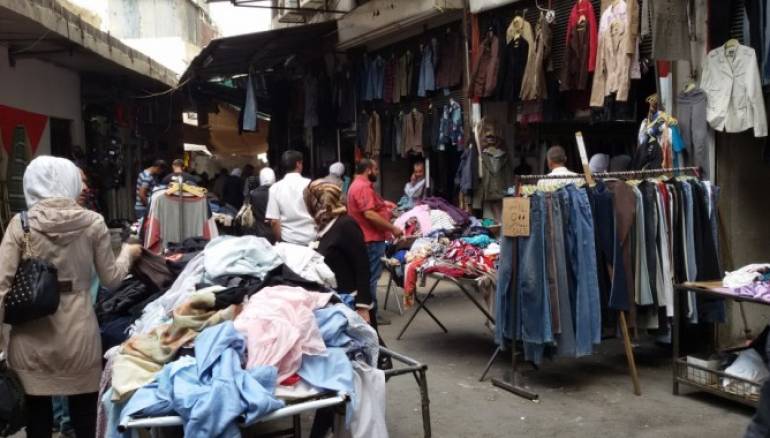It will be the 14th time an Eid holiday has arrived to the people in the capital since the outbreak of the Syrian revolution in 2011, but what is the situation of a simple Syrian citizen with limited income in this celebration?
The buying of new clothes is one of the means of expressing the joy of Eid, which has been lost by most Damascenes due to the low value of the Syrian pound, its weakened purchasing power and the total absence of the labor market, increasing the price of clothing dozens of times over.
This has pushed people to find alternatives and resort to the markets selling used items in an effort to secure Eid clothes for cheapest prices, and not to deprive children from the joy of the holiday.
The price of children's jeans ranges between 5,000 Syrian pounds to 8,000 Syrian pounds in the popular markets. In more upscale malls and shops, the lowest price one can find jeans is for 20,000 Syrian pounds ($40), while a government employee's salary is 50,000 Syrian pounds, according to a study prepared by the pro-Assad Al-Watan newspaper in the first quarter of last year.
Used clothes stalls, which are crowded in the holiday seasons, are a feature of the Damascus marketplaces, and there is no market or street without the existence of a number of these stores. These stalls are real and acceptable alternatives to the new clothes that families cannot afford, according to H.Z., a mother of three living in the Sheikh Saad area of Damascus.
She adds that clothing markets save money for families, and she can spend only $50 to provide gifts for her entire family, a saving of around $250 if buying from stores which are popular in the market. This has helped her save money for the priorities of life.
According to official data, the average income of the Syrian family before 2011 was between $400-$600 a month, but this number has plummeted after seven years of bloody war, driving the average income of a family to $150, if the husband and wife both work.
The used clothes market is not only visited by the poor but also by the wealthy, according to F.D. from the Zuhoor neighborhood in Damascus. She told Iqtissad the used clothes markets contain everything the family needs for clothing, from school uniforms to wedding clothes and underwear to shoes.
According to F.D., families in Damascus resort to buying from second-hand markets at the beginning of the winter and summer seasons, as well as the holidays and the beginning of the academic year.
"Everyone in the community comes to used-clothing markets and most of them are middle-class people," said J.R., the owner of a clothing store.
According to J.R., the low quality of domestically produced goods and the high price of imported products are the main reasons for the popularity of second-hand markets in the areas of Itfaiye and Sheikh Saad.
This article was edited by The Syrian Observer. Responsibility for the information and views set out in this article lies entirely with the author.


